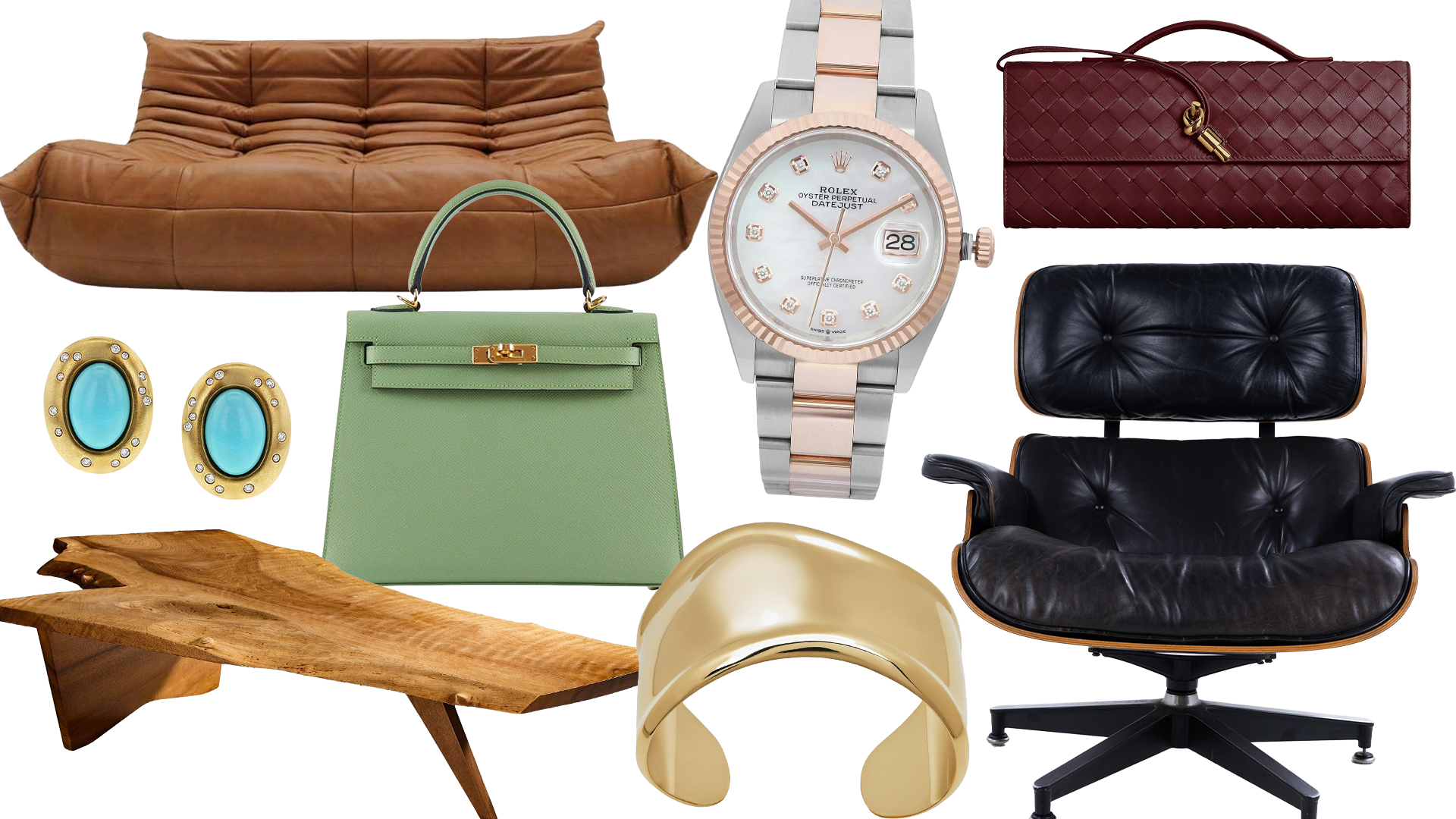Sotheby's "Trump Rally," Arta's Explosion & An E-Commerce Mystery
Welcome back to Wall Power’s Inner Circle. I’m . Please shut the door behind you.
Tonight, interviews , the founder of Arta, a company fueling an explosion of interest in more approachable fine art and collectibles by easing the bottleneck at the last mile—shipping, insurance, tracking, etcetera. There’s a lot of untapped demand at lower price points for galleries and
auction houses, especially smaller ones. It’s a fascinating conversation, and required reading for art professionals. You won’t want to miss it—sign up for the Inner Circle if you’re receiving the preview version of this private email.
But first…
A MESSAGE FROM OUR SPONSOR
Next, here’s Julie with a fascinating update on the vintage marketplace…
| Julie Brener Davich |

Photos: Courtesy of 1stDibs; Photo-Illustration: Puck
Last week, the high-end online salesroom 1stDibs
published its 2024 Luxury E-Commerce Report, a snapshot of the trends and top sales dominating its luxury, art, and design marketplace. The report illuminates a few interesting fashion and design trends. Some are in line with what you’d expect—like the popularity of mid-century modern design, Eames lounge chairs, and
furniture—while others are more surprising, such as buyer interest in Ligne Roset’s so-ugly-it’s-hip Togo seating, which rose 62 positions year over year in chair searches on the site. The company’s top-selling jewelry brand was Tiffany & Co., with orders growing 41 percent year over year—perhaps due to LVMH’s significant investment in the brand, as
my partner has noted. (If you’re not signed up for Lauren’s private email, Line Sheet, you just might not exist in this world. Fix that here.)
Meanwhile, Rolex accounted for three of the top five bestselling watch styles of the year. Buyers are snatching up deals as
prices for used Rolexes have sunk to a four-year low. No surprise that the top-selling handbags were from Hermès, with orders growing 57 percent year over year. Bottega Veneta was eighth on the list of the 10 top-selling handbag brands, but its orders grew 76 percent year over year. Louis Vuitton dropped from number one in handbags to number four.
Notably, the report—which 1stDibs hadn’t published since
2021, when the company went public—didn’t include some pertinent data points this time, such as the number of people actually using the platform. For that, I had to rummage through a 3Q24 investor deck I found online. The numbers aren’t quite apples to apples—the e-commerce report numbers are full-year, while the investor deck is T.T.M. (trailing 12 months) through 3Q24—but they are close enough for constructive comparison.
From 2018 to 2020, the number of active buyers on 1stDibs increased 49 percent, from 39,000 to 58,000. Over the next five years,
however, that number increased only 8 percent, to 62,500. Between 2019 and 2020, the gross merchandise value at 1stDibs grew 23 percent, from $279 million to $343 million. In 2024, however, the G.M.V. was only 3 percent higher, at $354 million. Meanwhile, the number of sellers between 2020 and 2024 increased from 4,200 to 7,000. In other words, 1stDibs appears to be attracting a lot more sellers, while the number of buyers, and items sold, has plateaued. And while that equates to more listing
fees in the short term, it’s a disquieting reflection of the company’s total addressable market. (1stDibs did not respond to a request for comment.)
Meanwhile, annual revenue traces a similar arc: $70.6 million in 2019, $102.7 million in 2021, then back down to $84.7 million in 2023. The company I.P.O.’d in June 2021, during the revenue peak, at $20 per share. These days, its stock price is down to around $3.60, an 85
percent decline. The revenue drop is unsurprising given the downturn in the luxury sector, but there are other indicators that the company is losing momentum. In 2020, the company sold 15 lots for $400,000 or above. In 2023, it sold only five.
And finally, Julie’s conversation with Adam Fields…

A candid conversation about digitizing the “last frontier” of
retail—luxury, art, and collectibles—and Arta’s evolution from its humble origins in 2012 to serving 80 percent of enterprise auction houses globally by the end of this year.
When Artspace.com founding member launched
Arta in 2012, hardly anyone could have predicted the company’s remarkable transformation. Over the past decade or so, Arta has evolved from a shipping platform into a broader commerce-layer technology meant to ease the process of buying and selling art, collectibles, and luxury items online. None of this is easy: For the past few, oh, centuries, once an artwork was purchased, it required high-touch handling
and multiple vendors to get it from seller to buyer. This was all very expensive and time-consuming for everyone involved.
Fields’s software has streamlined and digitized this process. Now, when a buyer checks out using Arta, they can insure, ship, and track their purchase with just a few clicks, using an interface that feels as familiar as buying something from Bloomingdale’s. Sellers, meanwhile, can divert their attention
and resources to other things. I don’t think it’s a stretch to say Arta’s software is helping to fuel the massive growth we’re seeing in the lower and middle markets—i.e., objects priced below $250,000. In fact, it might be one of the most quietly transformative drivers of today’s art market as a whole.
A MESSAGE FROM OUR SPONSOR
But can purchasing a painting at Art Basel ever be as easy as buying an Apple Watch? In this
lightly edited conversation, Fields explains why he thinks so…
Adam Fields: The art-luxury-collectibles ecosystem is really the last frontier of retail to be digitized. So the question is, how can you create a more frictionless and digitally-enabled buying and selling experience in this ecosystem? The biggest gap, at least initially, was on the purchase and post-purchase side.
We’ve been two different businesses over the years—the first launched in 2012, the second in 2020. The first was a place to say, “Hey, I have a very expensive piece of art. I need a specialized provider to get it from point A to point B. What are all
the bids that we can get?” But we recognized that didn’t solve that much of the problem.
So then we were trying to create solutions that would align with the entirety of a seller’s inventory: how to fill gaps between size, value, and geography—and not just for shipping, but for an entire transaction. And we’re not talking the $2 million item, but where the volume is zero to $250,000, which is the
vast majority of transactions.
There’s a lot of friction in the process, and a lot of risk. How do you confirm the item is authentic? That the buyer is who they say they are? That the title has changed? How can we lower risk from a loss, theft, or damage perspective? We recognized that we needed to get much more embedded into the experience. So around 2020—Covid time, which aligned well with a big
shift in buying and selling behavior—we relaunched our business as e-commerce technology for the collectible-luxury ecosystem that allows a seller to not just sell digitally, but also sell anything instantaneously on a global scale.
We expanded our shipping and fulfillment products to provide the optionality they need, and created a more standardized experience. By the end of this year, we’ll be
powering 80 percent of enterprise auction houses globally.
We went deep into two different areas: insurance and visibility. We’re licensed now as an InsurTech [company]. We have two insurance products, one of which is more on the shipping insurance protection [side]—which
has changed the game, because we’re essentially predicting and providing the logic on how items need to be packed, handled, and conveyed, to avoid the risk of it being lost, damaged, or stolen. In turn, we’ve been able to dramatically expand the value limits of which items can move through carrier supply chains like FedEx, UPS, and DHL.
Previously, you might have had to use a more specialized
carrier, which would be a lot more expensive for items in the $50,000 to $200,000 zone. Now we’re saying we can provide insurance coverage and make sure it’s packed correctly. All of a sudden, you’re getting things more cost effectively, with greater visibility and automation.
The visibility aspect is huge: Where is it? When is it going to get to me? The equivalent is buying something from
Bloomingdale’s and getting an email saying, “Your order is on its way to you.” That’s pretty common practice in retail. But to get that experience in art, you’d need to bundle up 10 different providers to buy, ship, insure, and track. Arta is doing it all in one.
The shipping part isn’t sexy, but if you can fill that gap, there’s a lot more you can get to. We want to become a one-stop-shop,
all-encompassing solution to power sellers, but also make it easier for buyers to buy.
The opportunity and acceptance of a digital transformation really accelerated around Covid. Part of it was people needing to work remotely, but it was really more the
straw that broke the camel’s back for businesses, in terms of, Okay, we’re unsure about our economic status, so we need to make sure that we’re watching how much we’re spending to service our operation. There were also more people coming into the market who were entering at lower price points.
It can be custom A.P.I. and custom development, or—because the space is still a bit antiquated—hosted products and solutions, which can be leveraged in a no-code or low-code environment. Artsy is very tech-first, so they took our A.P.I.s and built them out on their own. But a lot of the regional auction houses, like Rago or Leland Little, say, How can we get this up and running as soon as we can, with minimal resources?
A lot. People don’t really think about the buyer experience. We’re saying to sellers, “You can make this really easy, and if you make it really easy, you’re going to expand your market faster. You can expand who you can sell to, what you can sell, and where you can sell, and you’ll probably build more brand loyalty, retention, and repeat purchase rate.” Again, we’re not talking about
the million-dollar item. We’re talking about the lower to middle market stuff. That’s where the biggest opportunity is to grow—and it’s growing super fast.
Yes, and we’re starting to see the larger galleries take a page out of the auction model. They’re saying, We have a lot of inventory to move at this lower price point. Why are we throwing so many resources at that, when we should be throwing our resources at trying to sell the much more expensive, more complex stuff? So our business is starting to see a shift toward the gallery
space as well, which is a good thing because, again, it’s all about making things more scalable and creating a better purchase and post-purchase experience for the market.
Yes. The whole collectible memorabilia side—the trading cards, the comic books, the game-worn sneakers and jerseys—those are expanding this market from a size and interest standpoint, but they’re also more accessible price points. It’s providing a faster, better on-ramp. People are starting to recognize that collecting is fun. You can buy a card for a couple hundred bucks that has a lot of meaning to you, right? That’s the super cool part about
it. And because we’re providing tools for sellers to scale at these lower price points, it makes it economical for all parties from a business perspective.
A thousand percent. Again, we see a world where there will be a lot more hoops you need to go through to complete a purchase. So if you already have people verified from an identity, K.Y.C. (know your customer), A.M.L. (anti–money laundering) perspective, you can underwrite them from a risk perspective. Then it’s just what their shipping addresses are, what the taxes were—fully loaded taxes, whether it’s
sales tax, use tax, import and export costs—and have their payment methods stored. You can make it a much more frictionless experience, particularly when you can more digitally manage inventory of purchased items over time.
Yes. Where the seller is, where the item is being sold from, and where the buyer is located have a tremendous impact on cost, even from an insurance, tax, and shipping perspective. Generally, buyers aren’t able to make informed purchasing decisions, because they don’t know the entirety of what they’re getting themselves into.
We have clients saying, “Hey, we have buyers canceling sales, because they didn’t know that they had to pay a tax, a shipment cost, or something customs-related, and they didn’t realize how to pay X percent duty… You’re on it, right?” A lot of the sellers’ motivation here is financial, because they don’t want to have to deal with canceled sales or upset buyers.
Thanks, Julie. That’s all for this week’s Inner Circle dispatch. We’ve got more
interviews lined up, but let me know who in the art industry you’d like to hear from directly. Just hit reply, and I’ll do my best. As always, my cell is +1 917.825.1391, which works on WhatsApp, Signal, and regular SMS text. Give it a try. I’ll text you back.
M
The ultimate fashion industry bible, offering incisive reportage on all aspects of the business and its biggest
players. Anchored by preeminent fashion journalist Lauren Sherman, Line Sheet also features veteran reporter Rachel Strugatz, who delivers unparalleled intel on what’s happening in the beauty industry, and Sarah Shapiro, a longtime retail strategist who writes about e-commerce, brick-and-mortar, D.T.C., and more.
Join Emmy Award-winning journalist Peter Hamby, along with the team of expert journalists at Puck, as they let you
in on the conversations insiders are having across the four corners of power in America: Wall Street, Washington, Silicon Valley, and Hollywood. Presented in partnership with Audacy, new episodes publish daily, Monday through Friday.

Need help? Review our or for assistance. For brand partnerships, email [email protected].
You received this email because you signed up to receive emails from Puck, or as part of your Puck account associated with . To stop receiving this newsletter and/or manage all your email preferences, click
here.
Puck is published by Heat Media LLC. 107 Greenwich St, New York, NY 10006














